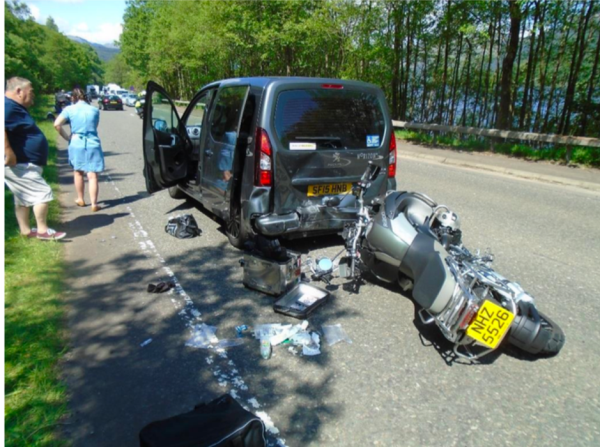Leslie O’Donnell v Lisa Smith and Royal & Sun Alliance Insurance

On 29th May 2016, Mr O’Donnell was riding his BMW R1200 GS on the A82 just south of Tarbet.
He was accompanied by two other motorcyclists and they were making their way north to Oban.
O’Donnell was the lead rider. At a point on the journey, he adopted a position approximately 50 to 60 metres behind a Peugeot being driven by Ms Smith. He was in the process of considering an overtake.
The straight section of road from the motorcyclist’s POV
Suddenly, Ms Smith performed an emergency stop. The motorcyclist attempted to brake but was unable to avoid a collision with the rear of the Peugeot.
The motorcyclist sustained significant injuries including a fractured right wrist and knee. He raised a claim against Ms Smith for personal injury.
Liability was disputed and the case proceeded to a full hearing. The driver argued that the following motorcyclist was at fault for running into the back of her.
Evidence was heard that the motorcyclist was travelling at around 55mph and at a distance of 50 to 60 metres from the vehicle in front. The driver’s explanation for the emergency stop was that she braked too sharply after becoming apprehensive about the presence of motorcyclists. She argued that despite her actions, the motorcyclist was to blame for riding too close to her and too fast so that he was unable to avoid colliding with her.
The Sherriff ruled that the driver who braked suddenly because she had become apprehensive at the sight of the motorcyclists was entirely at fault. In his Judgement, the Sheriff noted there was “no single rule which specifies the distance which should separate two vehicles travelling one behind the other” and “the mere fact of one vehicle having collided with the rear of another vehicle in front does not of itself give rise to the presumption that the driver of the following vehicle has been negligent”. A following driver is expected to drive in such a fashion as will enable him to deal successfully with all traffic exigencies “reasonably to be anticipated”.
DRIVER 100% TO BLAME MOTORCYCLIST 0% TO BLAME
There is no single rule that specifies the distance which should separate two vehicles travelling one behind the other. The Courts do not automatically hold the driver of the rear vehicle at fault for a rear end collision. The conduct of the driver in front will be scrutinised in any determination of fault. In this case, an emergency stop due to apprehension was not a traffic exigency that could have been reasonably anticipated by the motorcyclist.
The full judgement can be read here